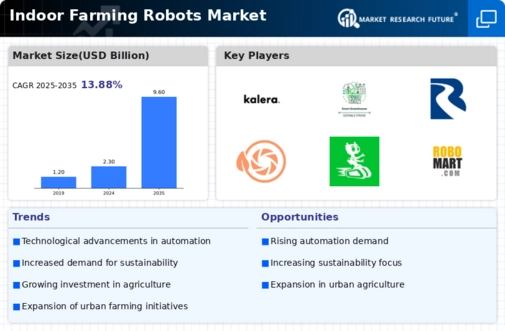Market Trends
Key Emerging Trends in the Indoor Farming Robots Market
The indoor farming robots market is witnessing several prominent trends that are reshaping the landscape of agricultural technology and driving the industry forward. One significant trend is the increasing adoption of vertical farming practices, fueled by the growing demand for fresh, locally grown produce in urban areas. Vertical farming utilizes stacked growing layers to maximize space efficiency, allowing farmers to cultivate crops in indoor environments such as warehouses, shipping containers, or urban high-rises. Indoor farming robots play a crucial role in vertical farming operations by automating tasks such as planting, watering, and harvesting, thereby increasing productivity and reducing labor costs.
Another notable trend is the integration of advanced technologies such as artificial intelligence (AI) and machine learning (ML) into indoor farming robots. These technologies enable robots to analyze vast amounts of data in real-time, allowing for more precise monitoring of plant health, optimization of growing conditions, and predictive maintenance of equipment. By harnessing AI and ML algorithms, indoor farming robots can adapt to changing environmental conditions, optimize resource usage, and improve crop yields, driving efficiency and profitability for growers.
Furthermore, there is a growing emphasis on sustainability and resource efficiency within the indoor farming robots market. As concerns about food security, climate change, and water scarcity escalate, there is an increased focus on developing farming solutions that minimize environmental impact and reduce reliance on conventional agriculture practices. Indoor farming robots offer several sustainability benefits, including the efficient use of water and nutrients, reduced pesticide use, and lower carbon emissions due to reduced transportation requirements. As sustainability becomes a top priority for consumers, governments, and businesses alike, the demand for indoor farming robots is expected to continue to rise.
Additionally, market trends in the indoor farming robots market reflect a shift towards modular and scalable solutions that cater to a diverse range of applications and environments. Modular systems allow farmers to customize their indoor farming setups based on their specific needs and preferences, whether they are cultivating leafy greens, herbs, or specialty crops. Scalable solutions enable farmers to start small and expand their operations over time as demand grows, providing flexibility and adaptability in an ever-changing market landscape.
Moreover, there is a growing trend towards the development of robotic solutions that address specific pain points and challenges faced by indoor farmers. For example, some companies are focusing on developing robots specialized in seedling transplantation, nutrient delivery, or pest management, offering targeted solutions to improve efficiency and reduce labor requirements. By addressing specific needs within the indoor farming ecosystem, these specialized robots help farmers overcome barriers to adoption and unlock new opportunities for growth and innovation.
However, market trends in the indoor farming robots market also highlight some challenges and areas for improvement. High upfront costs, technological complexities, and regulatory barriers can hinder the widespread adoption of indoor farming robots, particularly among small-scale farmers and growers. Additionally, concerns about data privacy, cybersecurity, and job displacement may impact market acceptance and adoption rates, requiring industry stakeholders to address these issues proactively.

















Leave a Comment